Strategic Training and Development Analysis for Telstra Corporation
VerifiedAdded on 2022/08/18
|12
|3571
|366
Report
AI Summary
This report analyzes the training and development needs of Telstra Corporation Limited, addressing issues of customer dissatisfaction and financial challenges. It identifies three key training needs: customer focus, communication and decision-making, and coaching/employee development. The report outlines a training program emphasizing employee development, aligning with business goals, communication, recognizing potential, and incorporating feedback. The program is underpinned by learning theories that drive organizational effectiveness. The report also describes the process to evaluate the success of the program, ensuring improved employee skills and enhanced customer satisfaction. The report highlights the importance of training and development for improving employee skills, customer satisfaction, and overall organizational performance.
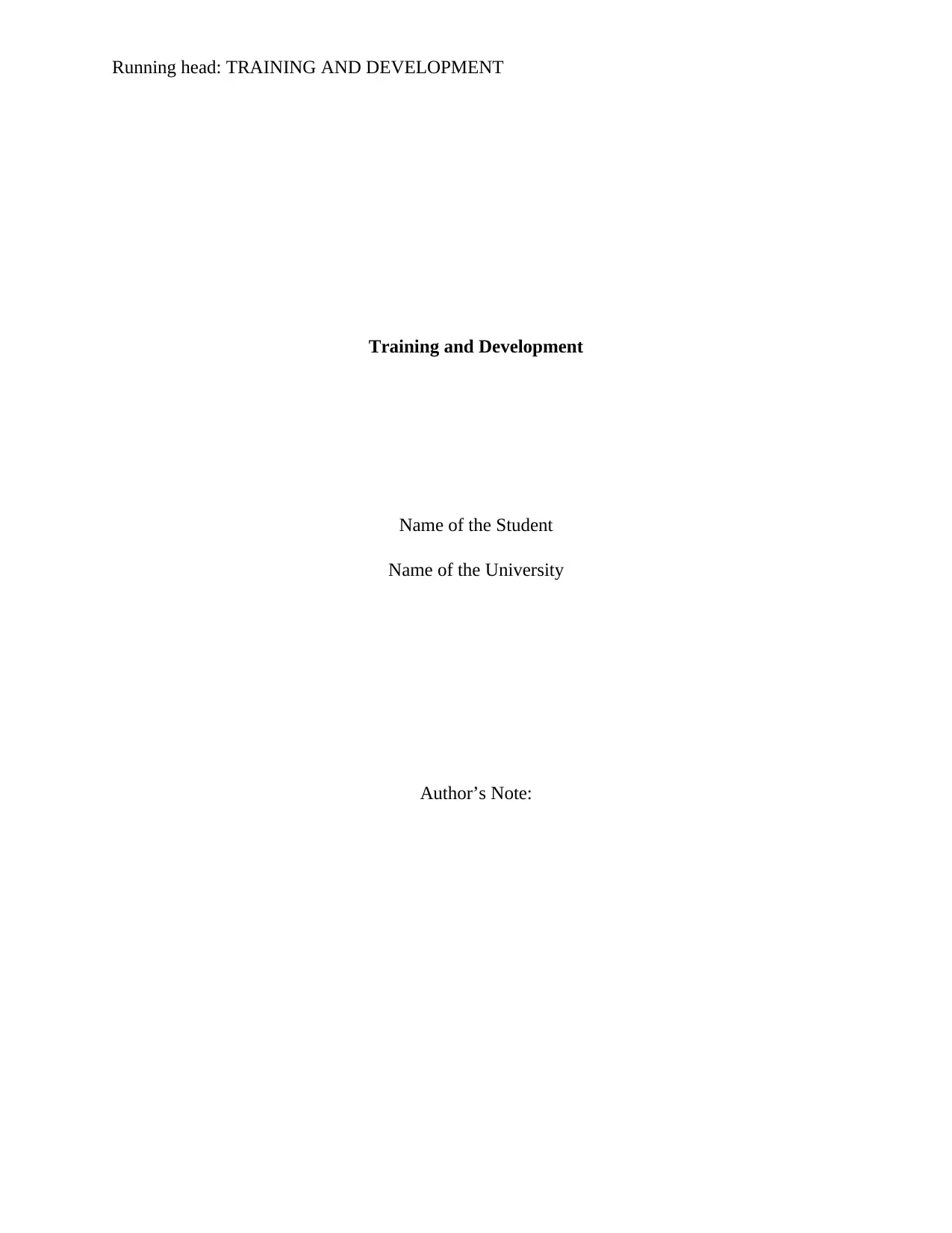
Running head: TRAINING AND DEVELOPMENT
Training and Development
Name of the Student
Name of the University
Author’s Note:
Training and Development
Name of the Student
Name of the University
Author’s Note:
Paraphrase This Document
Need a fresh take? Get an instant paraphrase of this document with our AI Paraphraser
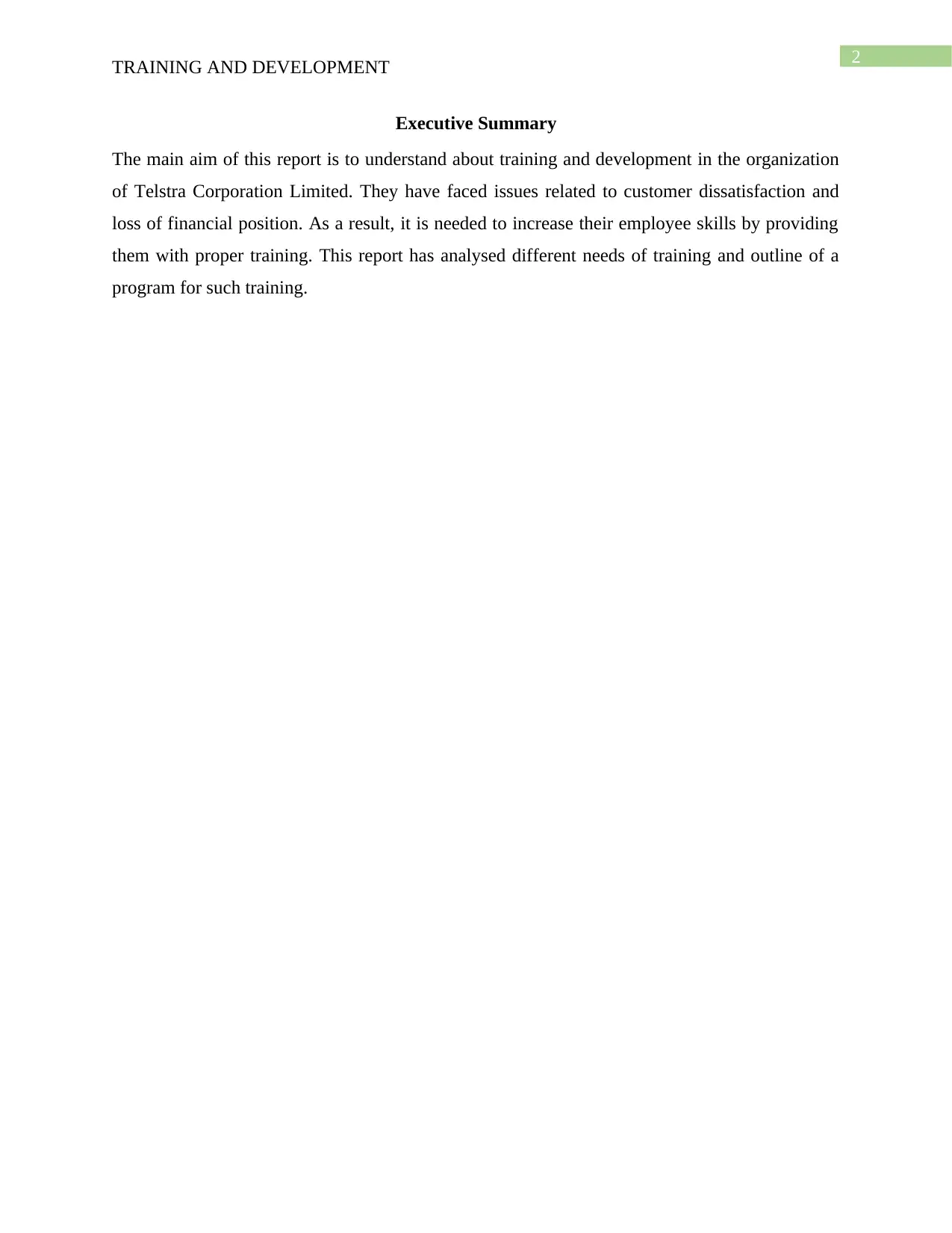
2
TRAINING AND DEVELOPMENT
Executive Summary
The main aim of this report is to understand about training and development in the organization
of Telstra Corporation Limited. They have faced issues related to customer dissatisfaction and
loss of financial position. As a result, it is needed to increase their employee skills by providing
them with proper training. This report has analysed different needs of training and outline of a
program for such training.
TRAINING AND DEVELOPMENT
Executive Summary
The main aim of this report is to understand about training and development in the organization
of Telstra Corporation Limited. They have faced issues related to customer dissatisfaction and
loss of financial position. As a result, it is needed to increase their employee skills by providing
them with proper training. This report has analysed different needs of training and outline of a
program for such training.

3
TRAINING AND DEVELOPMENT
Table of Contents
1. Introduction..................................................................................................................................4
2. Discussion....................................................................................................................................4
2.1 Description of the Strategic Business Issue in Telstra...........................................................4
2.2 Identification of 3 Training and Development Needs related to the Strategic Business Issue
in Telstra......................................................................................................................................5
2.3 Preparation of an Outline of a Training and Development Program for addressing one of
the Three Needs...........................................................................................................................7
2.4 Description of the Learning Theories that underpin the Design of the Training and
Development Program.................................................................................................................8
2.5 Description of the Process to Evaluate the Success of the Program in Telstra...................10
3. Conclusion.................................................................................................................................10
References......................................................................................................................................11
TRAINING AND DEVELOPMENT
Table of Contents
1. Introduction..................................................................................................................................4
2. Discussion....................................................................................................................................4
2.1 Description of the Strategic Business Issue in Telstra...........................................................4
2.2 Identification of 3 Training and Development Needs related to the Strategic Business Issue
in Telstra......................................................................................................................................5
2.3 Preparation of an Outline of a Training and Development Program for addressing one of
the Three Needs...........................................................................................................................7
2.4 Description of the Learning Theories that underpin the Design of the Training and
Development Program.................................................................................................................8
2.5 Description of the Process to Evaluate the Success of the Program in Telstra...................10
3. Conclusion.................................................................................................................................10
References......................................................................................................................................11
⊘ This is a preview!⊘
Do you want full access?
Subscribe today to unlock all pages.

Trusted by 1+ million students worldwide
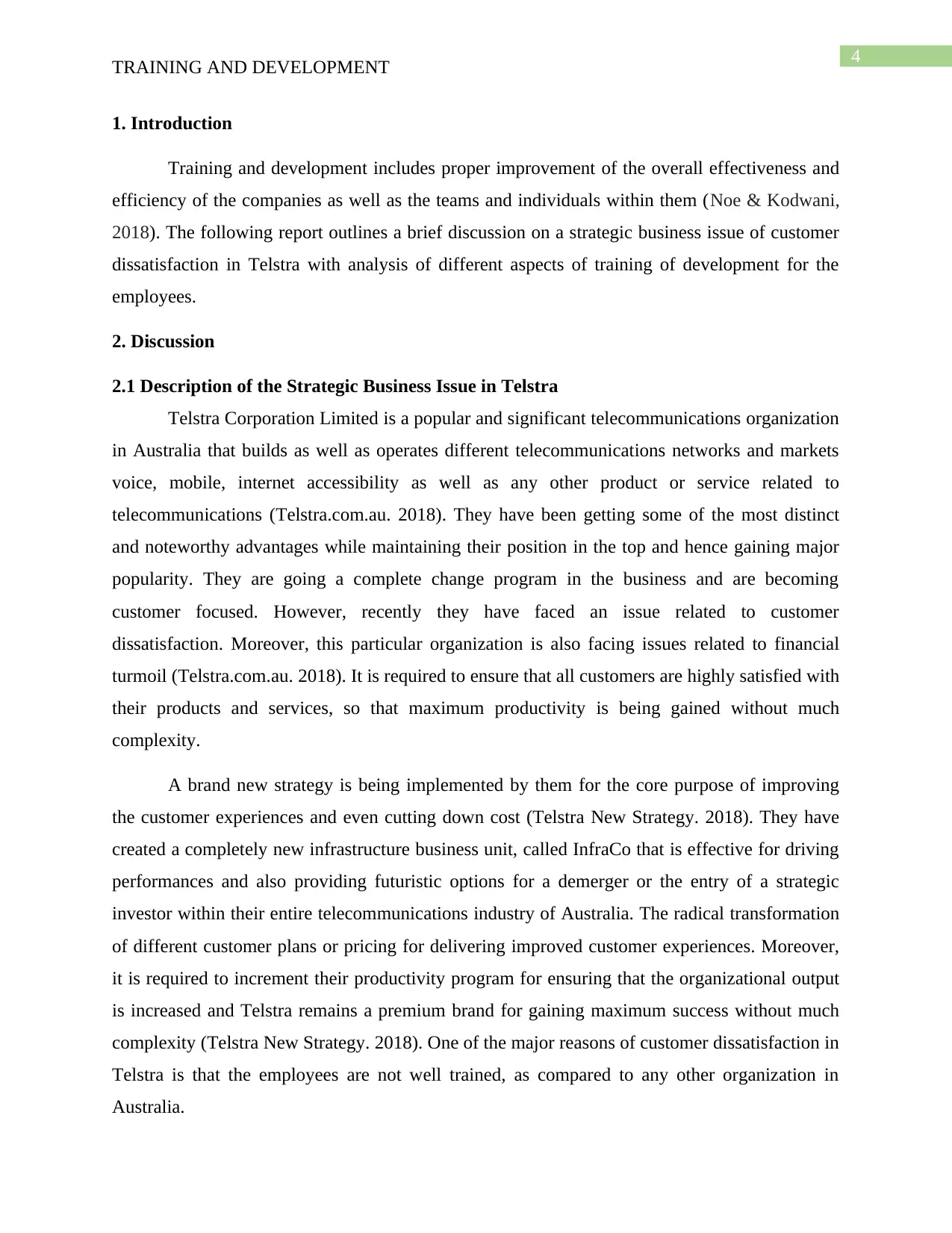
4
TRAINING AND DEVELOPMENT
1. Introduction
Training and development includes proper improvement of the overall effectiveness and
efficiency of the companies as well as the teams and individuals within them (Noe & Kodwani,
2018). The following report outlines a brief discussion on a strategic business issue of customer
dissatisfaction in Telstra with analysis of different aspects of training of development for the
employees.
2. Discussion
2.1 Description of the Strategic Business Issue in Telstra
Telstra Corporation Limited is a popular and significant telecommunications organization
in Australia that builds as well as operates different telecommunications networks and markets
voice, mobile, internet accessibility as well as any other product or service related to
telecommunications (Telstra.com.au. 2018). They have been getting some of the most distinct
and noteworthy advantages while maintaining their position in the top and hence gaining major
popularity. They are going a complete change program in the business and are becoming
customer focused. However, recently they have faced an issue related to customer
dissatisfaction. Moreover, this particular organization is also facing issues related to financial
turmoil (Telstra.com.au. 2018). It is required to ensure that all customers are highly satisfied with
their products and services, so that maximum productivity is being gained without much
complexity.
A brand new strategy is being implemented by them for the core purpose of improving
the customer experiences and even cutting down cost (Telstra New Strategy. 2018). They have
created a completely new infrastructure business unit, called InfraCo that is effective for driving
performances and also providing futuristic options for a demerger or the entry of a strategic
investor within their entire telecommunications industry of Australia. The radical transformation
of different customer plans or pricing for delivering improved customer experiences. Moreover,
it is required to increment their productivity program for ensuring that the organizational output
is increased and Telstra remains a premium brand for gaining maximum success without much
complexity (Telstra New Strategy. 2018). One of the major reasons of customer dissatisfaction in
Telstra is that the employees are not well trained, as compared to any other organization in
Australia.
TRAINING AND DEVELOPMENT
1. Introduction
Training and development includes proper improvement of the overall effectiveness and
efficiency of the companies as well as the teams and individuals within them (Noe & Kodwani,
2018). The following report outlines a brief discussion on a strategic business issue of customer
dissatisfaction in Telstra with analysis of different aspects of training of development for the
employees.
2. Discussion
2.1 Description of the Strategic Business Issue in Telstra
Telstra Corporation Limited is a popular and significant telecommunications organization
in Australia that builds as well as operates different telecommunications networks and markets
voice, mobile, internet accessibility as well as any other product or service related to
telecommunications (Telstra.com.au. 2018). They have been getting some of the most distinct
and noteworthy advantages while maintaining their position in the top and hence gaining major
popularity. They are going a complete change program in the business and are becoming
customer focused. However, recently they have faced an issue related to customer
dissatisfaction. Moreover, this particular organization is also facing issues related to financial
turmoil (Telstra.com.au. 2018). It is required to ensure that all customers are highly satisfied with
their products and services, so that maximum productivity is being gained without much
complexity.
A brand new strategy is being implemented by them for the core purpose of improving
the customer experiences and even cutting down cost (Telstra New Strategy. 2018). They have
created a completely new infrastructure business unit, called InfraCo that is effective for driving
performances and also providing futuristic options for a demerger or the entry of a strategic
investor within their entire telecommunications industry of Australia. The radical transformation
of different customer plans or pricing for delivering improved customer experiences. Moreover,
it is required to increment their productivity program for ensuring that the organizational output
is increased and Telstra remains a premium brand for gaining maximum success without much
complexity (Telstra New Strategy. 2018). One of the major reasons of customer dissatisfaction in
Telstra is that the employees are not well trained, as compared to any other organization in
Australia.
Paraphrase This Document
Need a fresh take? Get an instant paraphrase of this document with our AI Paraphraser
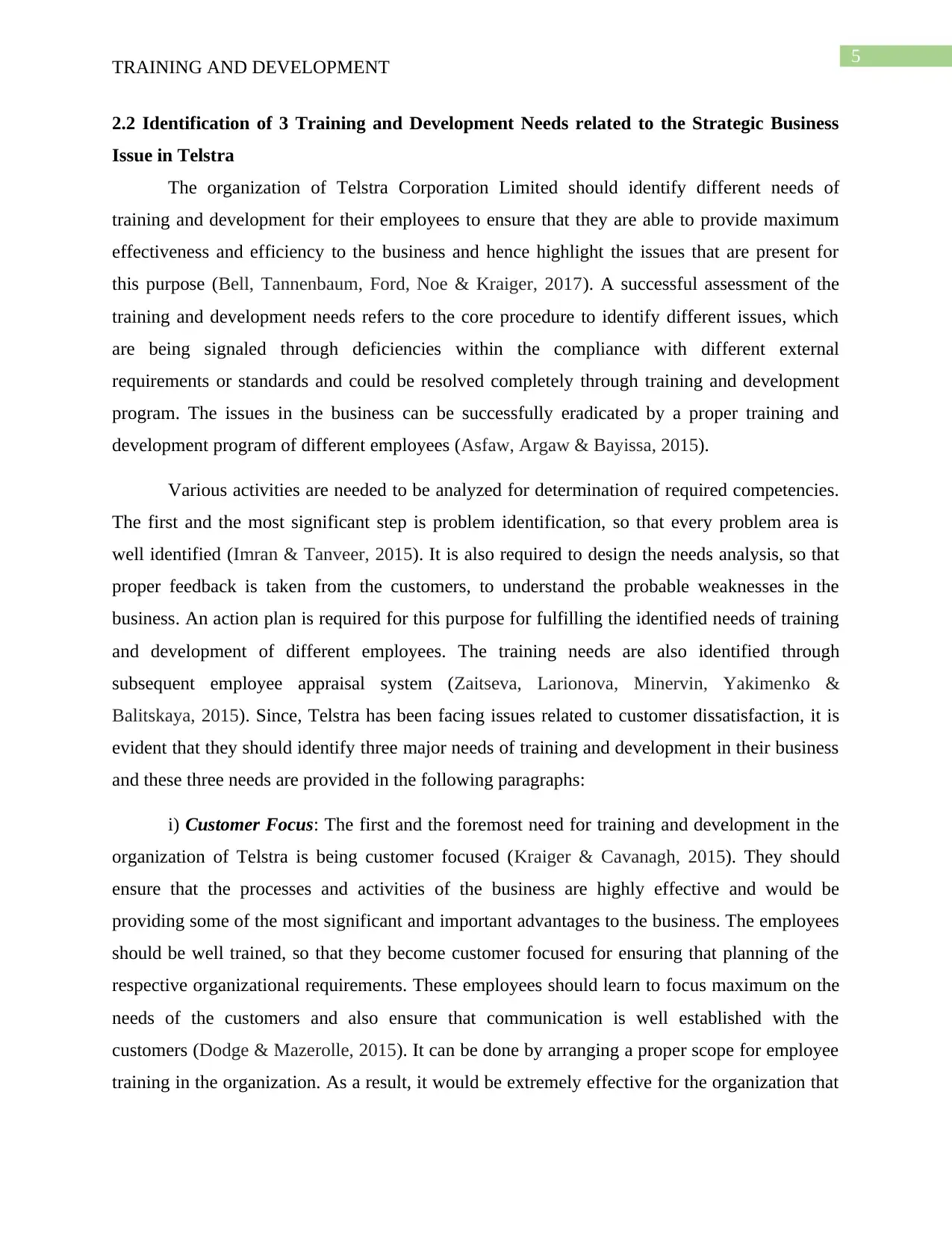
5
TRAINING AND DEVELOPMENT
2.2 Identification of 3 Training and Development Needs related to the Strategic Business
Issue in Telstra
The organization of Telstra Corporation Limited should identify different needs of
training and development for their employees to ensure that they are able to provide maximum
effectiveness and efficiency to the business and hence highlight the issues that are present for
this purpose (Bell, Tannenbaum, Ford, Noe & Kraiger, 2017). A successful assessment of the
training and development needs refers to the core procedure to identify different issues, which
are being signaled through deficiencies within the compliance with different external
requirements or standards and could be resolved completely through training and development
program. The issues in the business can be successfully eradicated by a proper training and
development program of different employees (Asfaw, Argaw & Bayissa, 2015).
Various activities are needed to be analyzed for determination of required competencies.
The first and the most significant step is problem identification, so that every problem area is
well identified (Imran & Tanveer, 2015). It is also required to design the needs analysis, so that
proper feedback is taken from the customers, to understand the probable weaknesses in the
business. An action plan is required for this purpose for fulfilling the identified needs of training
and development of different employees. The training needs are also identified through
subsequent employee appraisal system (Zaitseva, Larionova, Minervin, Yakimenko &
Balitskaya, 2015). Since, Telstra has been facing issues related to customer dissatisfaction, it is
evident that they should identify three major needs of training and development in their business
and these three needs are provided in the following paragraphs:
i) Customer Focus: The first and the foremost need for training and development in the
organization of Telstra is being customer focused (Kraiger & Cavanagh, 2015). They should
ensure that the processes and activities of the business are highly effective and would be
providing some of the most significant and important advantages to the business. The employees
should be well trained, so that they become customer focused for ensuring that planning of the
respective organizational requirements. These employees should learn to focus maximum on the
needs of the customers and also ensure that communication is well established with the
customers (Dodge & Mazerolle, 2015). It can be done by arranging a proper scope for employee
training in the organization. As a result, it would be extremely effective for the organization that
TRAINING AND DEVELOPMENT
2.2 Identification of 3 Training and Development Needs related to the Strategic Business
Issue in Telstra
The organization of Telstra Corporation Limited should identify different needs of
training and development for their employees to ensure that they are able to provide maximum
effectiveness and efficiency to the business and hence highlight the issues that are present for
this purpose (Bell, Tannenbaum, Ford, Noe & Kraiger, 2017). A successful assessment of the
training and development needs refers to the core procedure to identify different issues, which
are being signaled through deficiencies within the compliance with different external
requirements or standards and could be resolved completely through training and development
program. The issues in the business can be successfully eradicated by a proper training and
development program of different employees (Asfaw, Argaw & Bayissa, 2015).
Various activities are needed to be analyzed for determination of required competencies.
The first and the most significant step is problem identification, so that every problem area is
well identified (Imran & Tanveer, 2015). It is also required to design the needs analysis, so that
proper feedback is taken from the customers, to understand the probable weaknesses in the
business. An action plan is required for this purpose for fulfilling the identified needs of training
and development of different employees. The training needs are also identified through
subsequent employee appraisal system (Zaitseva, Larionova, Minervin, Yakimenko &
Balitskaya, 2015). Since, Telstra has been facing issues related to customer dissatisfaction, it is
evident that they should identify three major needs of training and development in their business
and these three needs are provided in the following paragraphs:
i) Customer Focus: The first and the foremost need for training and development in the
organization of Telstra is being customer focused (Kraiger & Cavanagh, 2015). They should
ensure that the processes and activities of the business are highly effective and would be
providing some of the most significant and important advantages to the business. The employees
should be well trained, so that they become customer focused for ensuring that planning of the
respective organizational requirements. These employees should learn to focus maximum on the
needs of the customers and also ensure that communication is well established with the
customers (Dodge & Mazerolle, 2015). It can be done by arranging a proper scope for employee
training in the organization. As a result, it would be extremely effective for the organization that
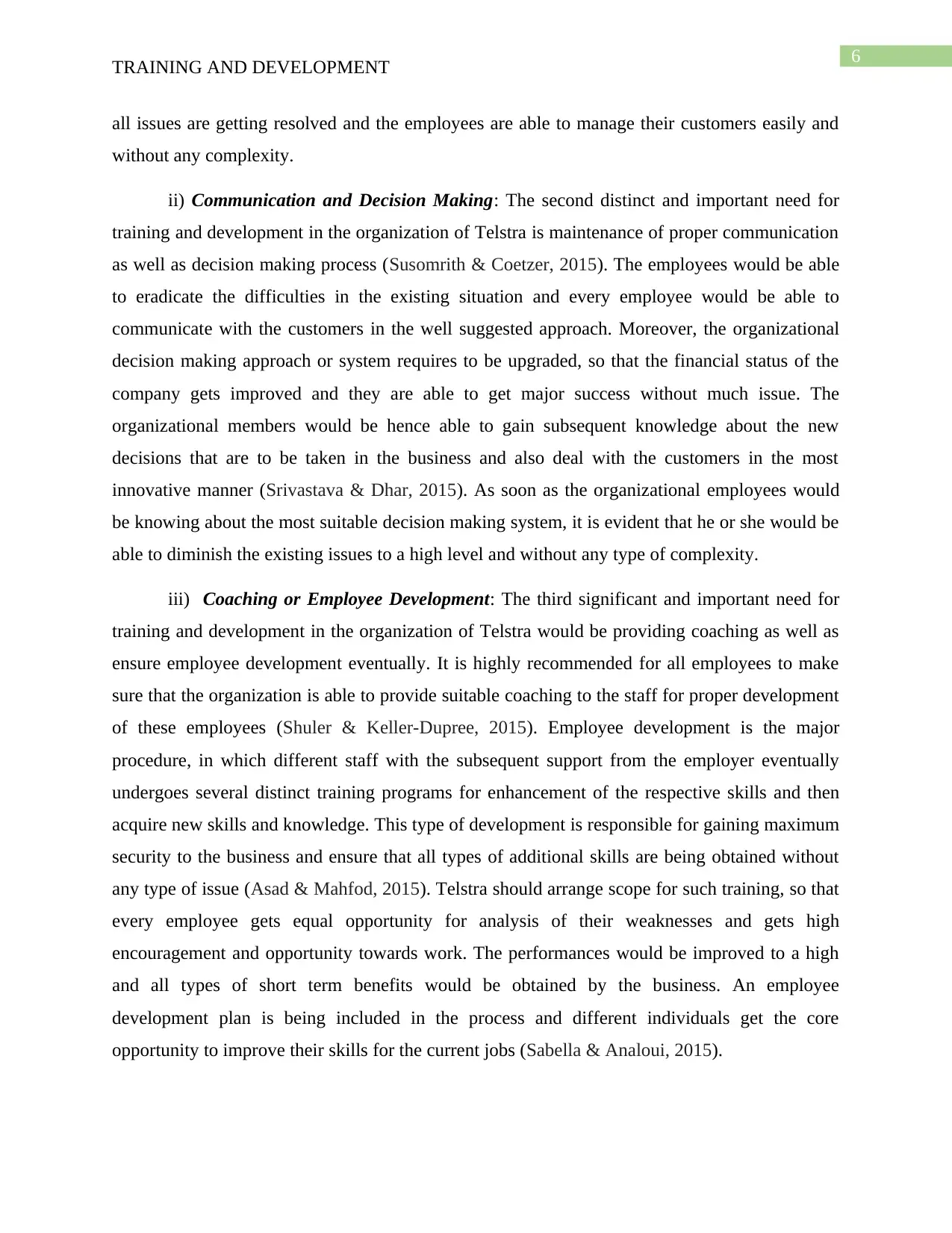
6
TRAINING AND DEVELOPMENT
all issues are getting resolved and the employees are able to manage their customers easily and
without any complexity.
ii) Communication and Decision Making: The second distinct and important need for
training and development in the organization of Telstra is maintenance of proper communication
as well as decision making process (Susomrith & Coetzer, 2015). The employees would be able
to eradicate the difficulties in the existing situation and every employee would be able to
communicate with the customers in the well suggested approach. Moreover, the organizational
decision making approach or system requires to be upgraded, so that the financial status of the
company gets improved and they are able to get major success without much issue. The
organizational members would be hence able to gain subsequent knowledge about the new
decisions that are to be taken in the business and also deal with the customers in the most
innovative manner (Srivastava & Dhar, 2015). As soon as the organizational employees would
be knowing about the most suitable decision making system, it is evident that he or she would be
able to diminish the existing issues to a high level and without any type of complexity.
iii) Coaching or Employee Development: The third significant and important need for
training and development in the organization of Telstra would be providing coaching as well as
ensure employee development eventually. It is highly recommended for all employees to make
sure that the organization is able to provide suitable coaching to the staff for proper development
of these employees (Shuler & Keller-Dupree, 2015). Employee development is the major
procedure, in which different staff with the subsequent support from the employer eventually
undergoes several distinct training programs for enhancement of the respective skills and then
acquire new skills and knowledge. This type of development is responsible for gaining maximum
security to the business and ensure that all types of additional skills are being obtained without
any type of issue (Asad & Mahfod, 2015). Telstra should arrange scope for such training, so that
every employee gets equal opportunity for analysis of their weaknesses and gets high
encouragement and opportunity towards work. The performances would be improved to a high
and all types of short term benefits would be obtained by the business. An employee
development plan is being included in the process and different individuals get the core
opportunity to improve their skills for the current jobs (Sabella & Analoui, 2015).
TRAINING AND DEVELOPMENT
all issues are getting resolved and the employees are able to manage their customers easily and
without any complexity.
ii) Communication and Decision Making: The second distinct and important need for
training and development in the organization of Telstra is maintenance of proper communication
as well as decision making process (Susomrith & Coetzer, 2015). The employees would be able
to eradicate the difficulties in the existing situation and every employee would be able to
communicate with the customers in the well suggested approach. Moreover, the organizational
decision making approach or system requires to be upgraded, so that the financial status of the
company gets improved and they are able to get major success without much issue. The
organizational members would be hence able to gain subsequent knowledge about the new
decisions that are to be taken in the business and also deal with the customers in the most
innovative manner (Srivastava & Dhar, 2015). As soon as the organizational employees would
be knowing about the most suitable decision making system, it is evident that he or she would be
able to diminish the existing issues to a high level and without any type of complexity.
iii) Coaching or Employee Development: The third significant and important need for
training and development in the organization of Telstra would be providing coaching as well as
ensure employee development eventually. It is highly recommended for all employees to make
sure that the organization is able to provide suitable coaching to the staff for proper development
of these employees (Shuler & Keller-Dupree, 2015). Employee development is the major
procedure, in which different staff with the subsequent support from the employer eventually
undergoes several distinct training programs for enhancement of the respective skills and then
acquire new skills and knowledge. This type of development is responsible for gaining maximum
security to the business and ensure that all types of additional skills are being obtained without
any type of issue (Asad & Mahfod, 2015). Telstra should arrange scope for such training, so that
every employee gets equal opportunity for analysis of their weaknesses and gets high
encouragement and opportunity towards work. The performances would be improved to a high
and all types of short term benefits would be obtained by the business. An employee
development plan is being included in the process and different individuals get the core
opportunity to improve their skills for the current jobs (Sabella & Analoui, 2015).
⊘ This is a preview!⊘
Do you want full access?
Subscribe today to unlock all pages.

Trusted by 1+ million students worldwide
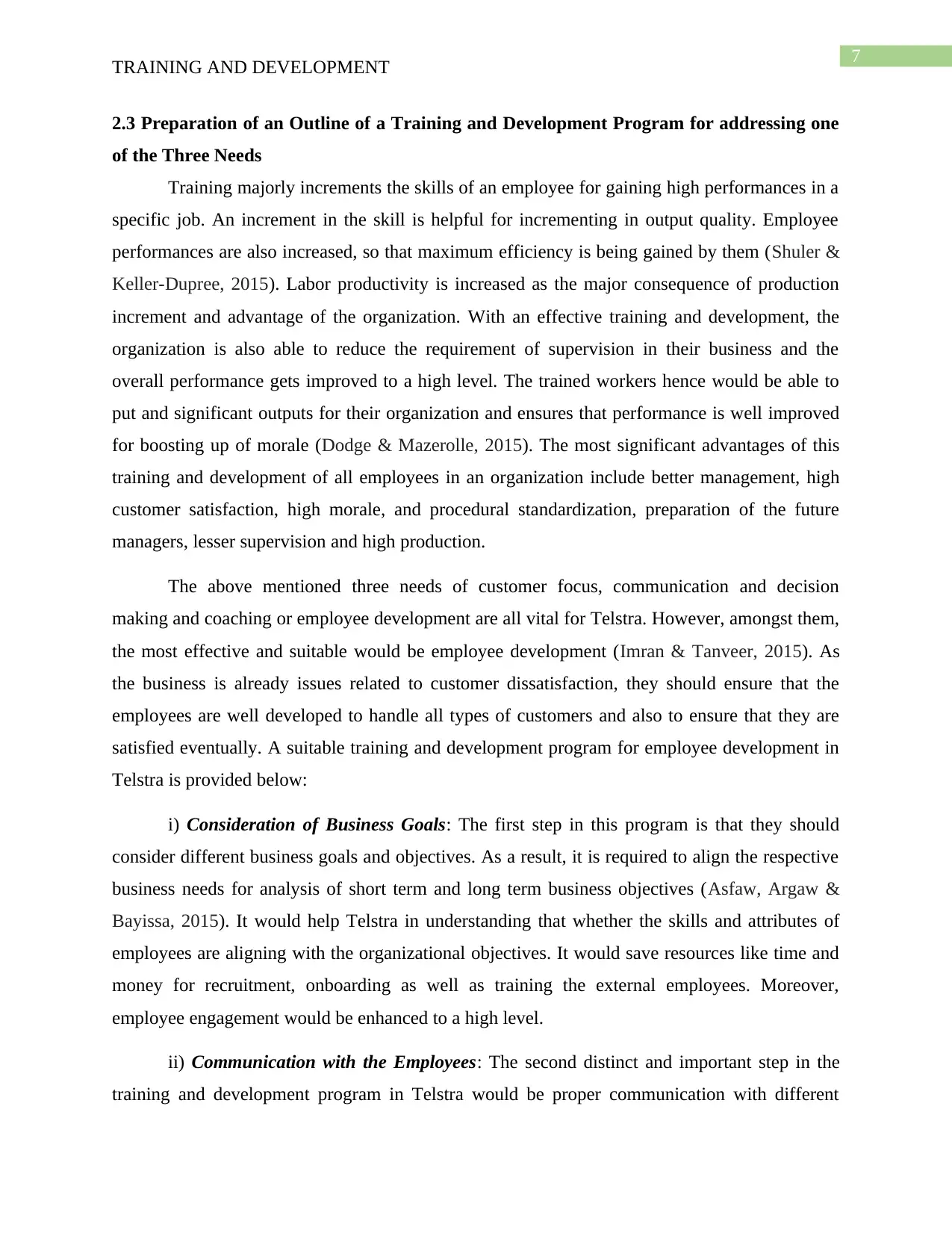
7
TRAINING AND DEVELOPMENT
2.3 Preparation of an Outline of a Training and Development Program for addressing one
of the Three Needs
Training majorly increments the skills of an employee for gaining high performances in a
specific job. An increment in the skill is helpful for incrementing in output quality. Employee
performances are also increased, so that maximum efficiency is being gained by them (Shuler &
Keller-Dupree, 2015). Labor productivity is increased as the major consequence of production
increment and advantage of the organization. With an effective training and development, the
organization is also able to reduce the requirement of supervision in their business and the
overall performance gets improved to a high level. The trained workers hence would be able to
put and significant outputs for their organization and ensures that performance is well improved
for boosting up of morale (Dodge & Mazerolle, 2015). The most significant advantages of this
training and development of all employees in an organization include better management, high
customer satisfaction, high morale, and procedural standardization, preparation of the future
managers, lesser supervision and high production.
The above mentioned three needs of customer focus, communication and decision
making and coaching or employee development are all vital for Telstra. However, amongst them,
the most effective and suitable would be employee development (Imran & Tanveer, 2015). As
the business is already issues related to customer dissatisfaction, they should ensure that the
employees are well developed to handle all types of customers and also to ensure that they are
satisfied eventually. A suitable training and development program for employee development in
Telstra is provided below:
i) Consideration of Business Goals: The first step in this program is that they should
consider different business goals and objectives. As a result, it is required to align the respective
business needs for analysis of short term and long term business objectives (Asfaw, Argaw &
Bayissa, 2015). It would help Telstra in understanding that whether the skills and attributes of
employees are aligning with the organizational objectives. It would save resources like time and
money for recruitment, onboarding as well as training the external employees. Moreover,
employee engagement would be enhanced to a high level.
ii) Communication with the Employees: The second distinct and important step in the
training and development program in Telstra would be proper communication with different
TRAINING AND DEVELOPMENT
2.3 Preparation of an Outline of a Training and Development Program for addressing one
of the Three Needs
Training majorly increments the skills of an employee for gaining high performances in a
specific job. An increment in the skill is helpful for incrementing in output quality. Employee
performances are also increased, so that maximum efficiency is being gained by them (Shuler &
Keller-Dupree, 2015). Labor productivity is increased as the major consequence of production
increment and advantage of the organization. With an effective training and development, the
organization is also able to reduce the requirement of supervision in their business and the
overall performance gets improved to a high level. The trained workers hence would be able to
put and significant outputs for their organization and ensures that performance is well improved
for boosting up of morale (Dodge & Mazerolle, 2015). The most significant advantages of this
training and development of all employees in an organization include better management, high
customer satisfaction, high morale, and procedural standardization, preparation of the future
managers, lesser supervision and high production.
The above mentioned three needs of customer focus, communication and decision
making and coaching or employee development are all vital for Telstra. However, amongst them,
the most effective and suitable would be employee development (Imran & Tanveer, 2015). As
the business is already issues related to customer dissatisfaction, they should ensure that the
employees are well developed to handle all types of customers and also to ensure that they are
satisfied eventually. A suitable training and development program for employee development in
Telstra is provided below:
i) Consideration of Business Goals: The first step in this program is that they should
consider different business goals and objectives. As a result, it is required to align the respective
business needs for analysis of short term and long term business objectives (Asfaw, Argaw &
Bayissa, 2015). It would help Telstra in understanding that whether the skills and attributes of
employees are aligning with the organizational objectives. It would save resources like time and
money for recruitment, onboarding as well as training the external employees. Moreover,
employee engagement would be enhanced to a high level.
ii) Communication with the Employees: The second distinct and important step in the
training and development program in Telstra would be proper communication with different
Paraphrase This Document
Need a fresh take? Get an instant paraphrase of this document with our AI Paraphraser
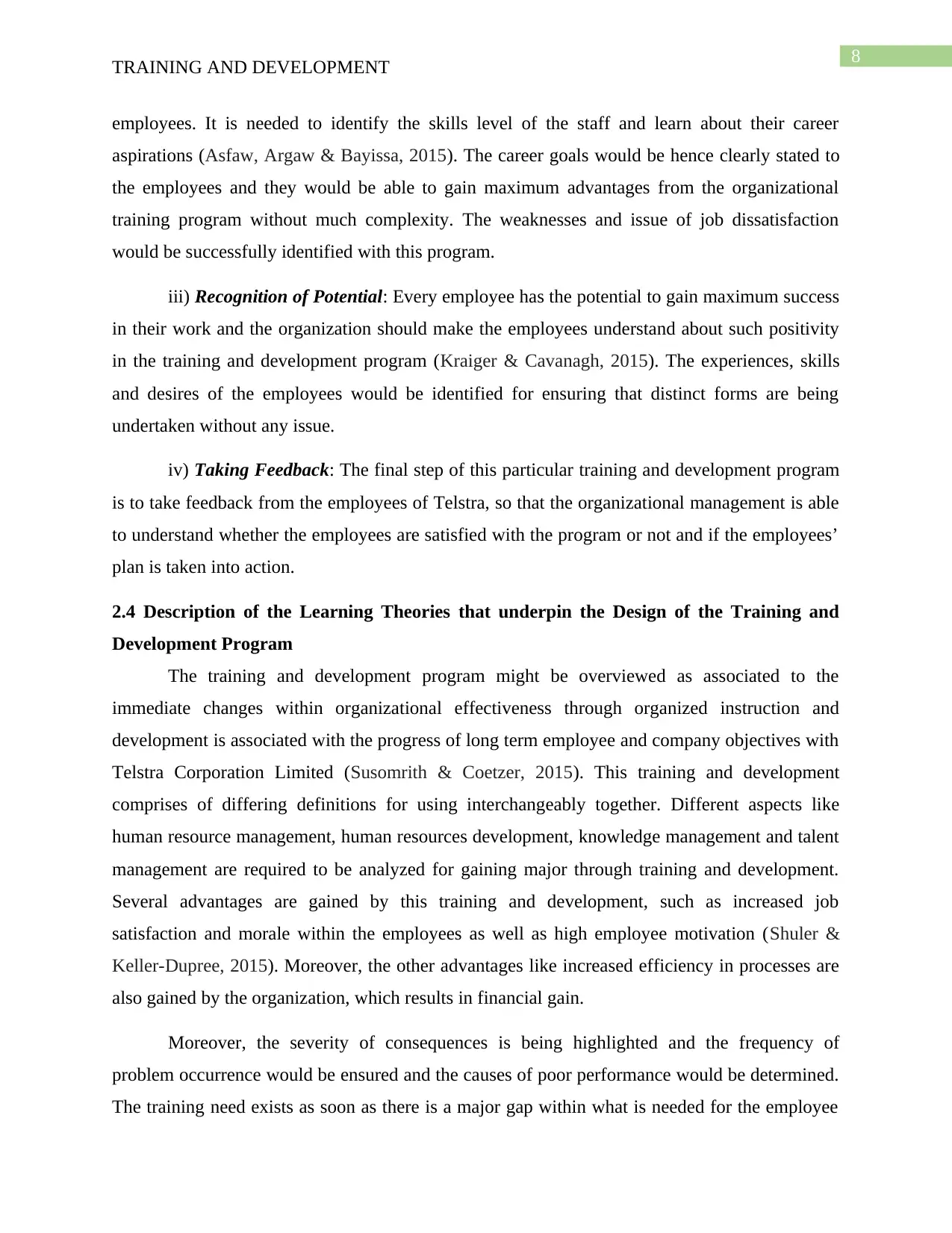
8
TRAINING AND DEVELOPMENT
employees. It is needed to identify the skills level of the staff and learn about their career
aspirations (Asfaw, Argaw & Bayissa, 2015). The career goals would be hence clearly stated to
the employees and they would be able to gain maximum advantages from the organizational
training program without much complexity. The weaknesses and issue of job dissatisfaction
would be successfully identified with this program.
iii) Recognition of Potential: Every employee has the potential to gain maximum success
in their work and the organization should make the employees understand about such positivity
in the training and development program (Kraiger & Cavanagh, 2015). The experiences, skills
and desires of the employees would be identified for ensuring that distinct forms are being
undertaken without any issue.
iv) Taking Feedback: The final step of this particular training and development program
is to take feedback from the employees of Telstra, so that the organizational management is able
to understand whether the employees are satisfied with the program or not and if the employees’
plan is taken into action.
2.4 Description of the Learning Theories that underpin the Design of the Training and
Development Program
The training and development program might be overviewed as associated to the
immediate changes within organizational effectiveness through organized instruction and
development is associated with the progress of long term employee and company objectives with
Telstra Corporation Limited (Susomrith & Coetzer, 2015). This training and development
comprises of differing definitions for using interchangeably together. Different aspects like
human resource management, human resources development, knowledge management and talent
management are required to be analyzed for gaining major through training and development.
Several advantages are gained by this training and development, such as increased job
satisfaction and morale within the employees as well as high employee motivation (Shuler &
Keller-Dupree, 2015). Moreover, the other advantages like increased efficiency in processes are
also gained by the organization, which results in financial gain.
Moreover, the severity of consequences is being highlighted and the frequency of
problem occurrence would be ensured and the causes of poor performance would be determined.
The training need exists as soon as there is a major gap within what is needed for the employee
TRAINING AND DEVELOPMENT
employees. It is needed to identify the skills level of the staff and learn about their career
aspirations (Asfaw, Argaw & Bayissa, 2015). The career goals would be hence clearly stated to
the employees and they would be able to gain maximum advantages from the organizational
training program without much complexity. The weaknesses and issue of job dissatisfaction
would be successfully identified with this program.
iii) Recognition of Potential: Every employee has the potential to gain maximum success
in their work and the organization should make the employees understand about such positivity
in the training and development program (Kraiger & Cavanagh, 2015). The experiences, skills
and desires of the employees would be identified for ensuring that distinct forms are being
undertaken without any issue.
iv) Taking Feedback: The final step of this particular training and development program
is to take feedback from the employees of Telstra, so that the organizational management is able
to understand whether the employees are satisfied with the program or not and if the employees’
plan is taken into action.
2.4 Description of the Learning Theories that underpin the Design of the Training and
Development Program
The training and development program might be overviewed as associated to the
immediate changes within organizational effectiveness through organized instruction and
development is associated with the progress of long term employee and company objectives with
Telstra Corporation Limited (Susomrith & Coetzer, 2015). This training and development
comprises of differing definitions for using interchangeably together. Different aspects like
human resource management, human resources development, knowledge management and talent
management are required to be analyzed for gaining major through training and development.
Several advantages are gained by this training and development, such as increased job
satisfaction and morale within the employees as well as high employee motivation (Shuler &
Keller-Dupree, 2015). Moreover, the other advantages like increased efficiency in processes are
also gained by the organization, which results in financial gain.
Moreover, the severity of consequences is being highlighted and the frequency of
problem occurrence would be ensured and the causes of poor performance would be determined.
The training need exists as soon as there is a major gap within what is needed for the employee
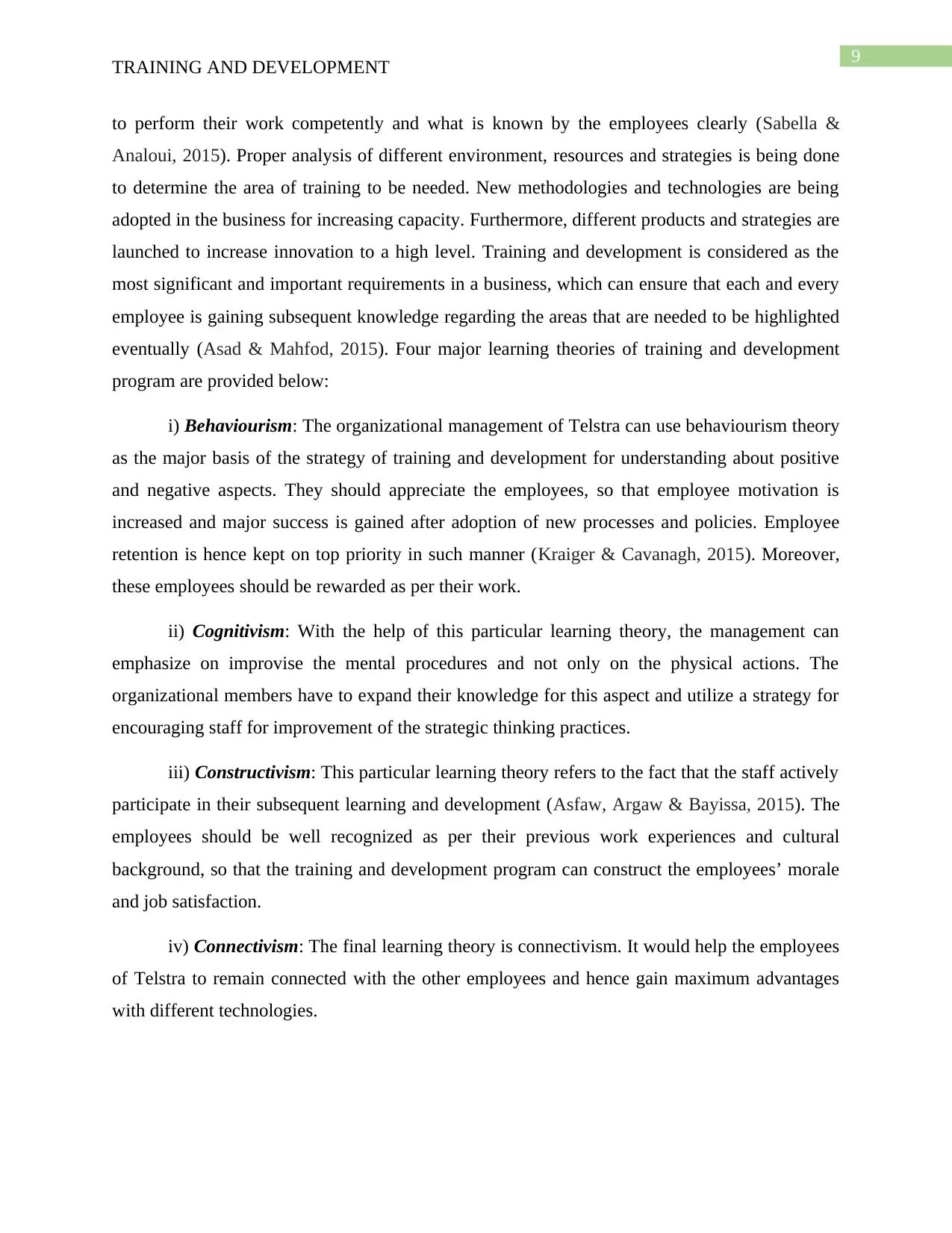
9
TRAINING AND DEVELOPMENT
to perform their work competently and what is known by the employees clearly (Sabella &
Analoui, 2015). Proper analysis of different environment, resources and strategies is being done
to determine the area of training to be needed. New methodologies and technologies are being
adopted in the business for increasing capacity. Furthermore, different products and strategies are
launched to increase innovation to a high level. Training and development is considered as the
most significant and important requirements in a business, which can ensure that each and every
employee is gaining subsequent knowledge regarding the areas that are needed to be highlighted
eventually (Asad & Mahfod, 2015). Four major learning theories of training and development
program are provided below:
i) Behaviourism: The organizational management of Telstra can use behaviourism theory
as the major basis of the strategy of training and development for understanding about positive
and negative aspects. They should appreciate the employees, so that employee motivation is
increased and major success is gained after adoption of new processes and policies. Employee
retention is hence kept on top priority in such manner (Kraiger & Cavanagh, 2015). Moreover,
these employees should be rewarded as per their work.
ii) Cognitivism: With the help of this particular learning theory, the management can
emphasize on improvise the mental procedures and not only on the physical actions. The
organizational members have to expand their knowledge for this aspect and utilize a strategy for
encouraging staff for improvement of the strategic thinking practices.
iii) Constructivism: This particular learning theory refers to the fact that the staff actively
participate in their subsequent learning and development (Asfaw, Argaw & Bayissa, 2015). The
employees should be well recognized as per their previous work experiences and cultural
background, so that the training and development program can construct the employees’ morale
and job satisfaction.
iv) Connectivism: The final learning theory is connectivism. It would help the employees
of Telstra to remain connected with the other employees and hence gain maximum advantages
with different technologies.
TRAINING AND DEVELOPMENT
to perform their work competently and what is known by the employees clearly (Sabella &
Analoui, 2015). Proper analysis of different environment, resources and strategies is being done
to determine the area of training to be needed. New methodologies and technologies are being
adopted in the business for increasing capacity. Furthermore, different products and strategies are
launched to increase innovation to a high level. Training and development is considered as the
most significant and important requirements in a business, which can ensure that each and every
employee is gaining subsequent knowledge regarding the areas that are needed to be highlighted
eventually (Asad & Mahfod, 2015). Four major learning theories of training and development
program are provided below:
i) Behaviourism: The organizational management of Telstra can use behaviourism theory
as the major basis of the strategy of training and development for understanding about positive
and negative aspects. They should appreciate the employees, so that employee motivation is
increased and major success is gained after adoption of new processes and policies. Employee
retention is hence kept on top priority in such manner (Kraiger & Cavanagh, 2015). Moreover,
these employees should be rewarded as per their work.
ii) Cognitivism: With the help of this particular learning theory, the management can
emphasize on improvise the mental procedures and not only on the physical actions. The
organizational members have to expand their knowledge for this aspect and utilize a strategy for
encouraging staff for improvement of the strategic thinking practices.
iii) Constructivism: This particular learning theory refers to the fact that the staff actively
participate in their subsequent learning and development (Asfaw, Argaw & Bayissa, 2015). The
employees should be well recognized as per their previous work experiences and cultural
background, so that the training and development program can construct the employees’ morale
and job satisfaction.
iv) Connectivism: The final learning theory is connectivism. It would help the employees
of Telstra to remain connected with the other employees and hence gain maximum advantages
with different technologies.
⊘ This is a preview!⊘
Do you want full access?
Subscribe today to unlock all pages.

Trusted by 1+ million students worldwide
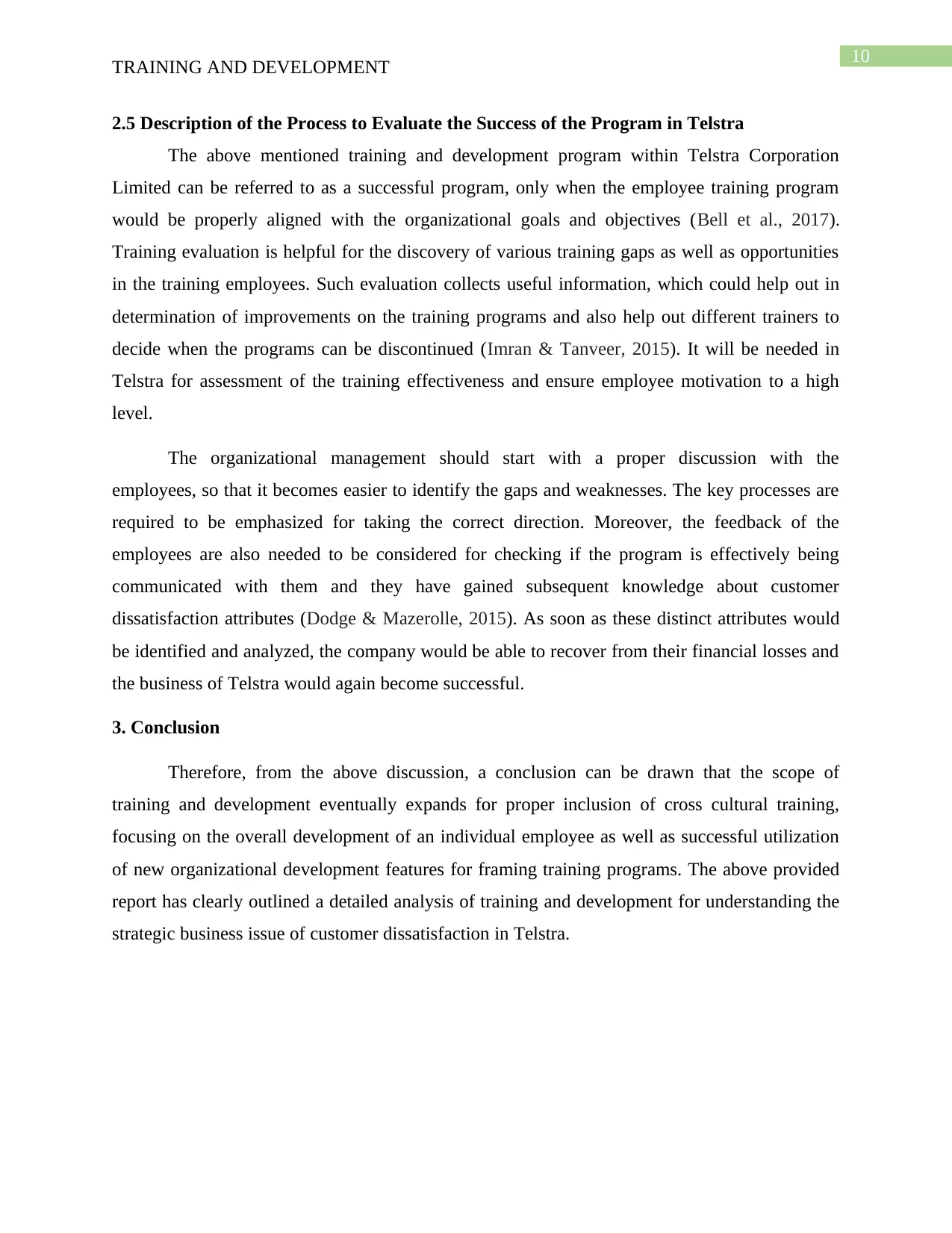
10
TRAINING AND DEVELOPMENT
2.5 Description of the Process to Evaluate the Success of the Program in Telstra
The above mentioned training and development program within Telstra Corporation
Limited can be referred to as a successful program, only when the employee training program
would be properly aligned with the organizational goals and objectives (Bell et al., 2017).
Training evaluation is helpful for the discovery of various training gaps as well as opportunities
in the training employees. Such evaluation collects useful information, which could help out in
determination of improvements on the training programs and also help out different trainers to
decide when the programs can be discontinued (Imran & Tanveer, 2015). It will be needed in
Telstra for assessment of the training effectiveness and ensure employee motivation to a high
level.
The organizational management should start with a proper discussion with the
employees, so that it becomes easier to identify the gaps and weaknesses. The key processes are
required to be emphasized for taking the correct direction. Moreover, the feedback of the
employees are also needed to be considered for checking if the program is effectively being
communicated with them and they have gained subsequent knowledge about customer
dissatisfaction attributes (Dodge & Mazerolle, 2015). As soon as these distinct attributes would
be identified and analyzed, the company would be able to recover from their financial losses and
the business of Telstra would again become successful.
3. Conclusion
Therefore, from the above discussion, a conclusion can be drawn that the scope of
training and development eventually expands for proper inclusion of cross cultural training,
focusing on the overall development of an individual employee as well as successful utilization
of new organizational development features for framing training programs. The above provided
report has clearly outlined a detailed analysis of training and development for understanding the
strategic business issue of customer dissatisfaction in Telstra.
TRAINING AND DEVELOPMENT
2.5 Description of the Process to Evaluate the Success of the Program in Telstra
The above mentioned training and development program within Telstra Corporation
Limited can be referred to as a successful program, only when the employee training program
would be properly aligned with the organizational goals and objectives (Bell et al., 2017).
Training evaluation is helpful for the discovery of various training gaps as well as opportunities
in the training employees. Such evaluation collects useful information, which could help out in
determination of improvements on the training programs and also help out different trainers to
decide when the programs can be discontinued (Imran & Tanveer, 2015). It will be needed in
Telstra for assessment of the training effectiveness and ensure employee motivation to a high
level.
The organizational management should start with a proper discussion with the
employees, so that it becomes easier to identify the gaps and weaknesses. The key processes are
required to be emphasized for taking the correct direction. Moreover, the feedback of the
employees are also needed to be considered for checking if the program is effectively being
communicated with them and they have gained subsequent knowledge about customer
dissatisfaction attributes (Dodge & Mazerolle, 2015). As soon as these distinct attributes would
be identified and analyzed, the company would be able to recover from their financial losses and
the business of Telstra would again become successful.
3. Conclusion
Therefore, from the above discussion, a conclusion can be drawn that the scope of
training and development eventually expands for proper inclusion of cross cultural training,
focusing on the overall development of an individual employee as well as successful utilization
of new organizational development features for framing training programs. The above provided
report has clearly outlined a detailed analysis of training and development for understanding the
strategic business issue of customer dissatisfaction in Telstra.
Paraphrase This Document
Need a fresh take? Get an instant paraphrase of this document with our AI Paraphraser
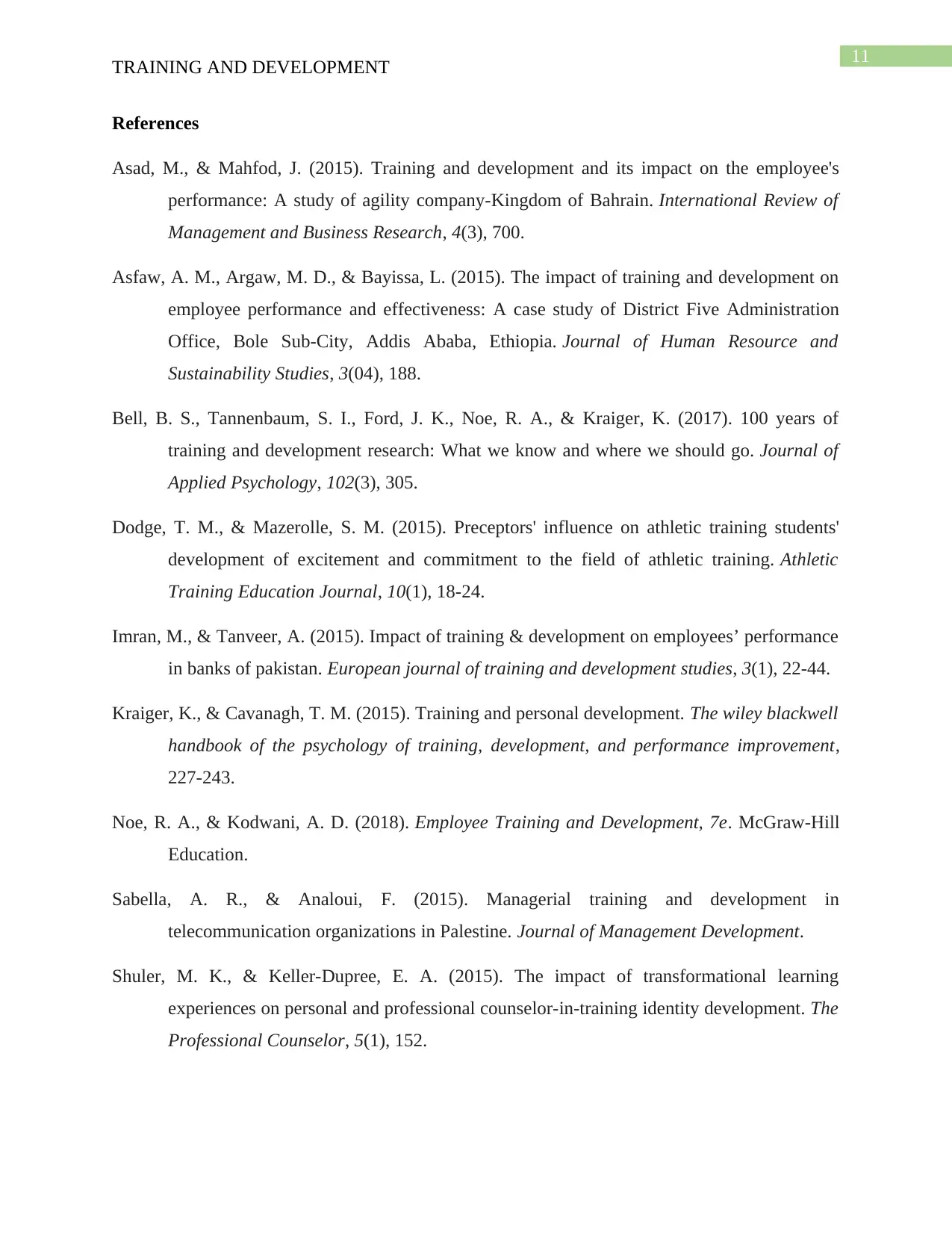
11
TRAINING AND DEVELOPMENT
References
Asad, M., & Mahfod, J. (2015). Training and development and its impact on the employee's
performance: A study of agility company-Kingdom of Bahrain. International Review of
Management and Business Research, 4(3), 700.
Asfaw, A. M., Argaw, M. D., & Bayissa, L. (2015). The impact of training and development on
employee performance and effectiveness: A case study of District Five Administration
Office, Bole Sub-City, Addis Ababa, Ethiopia. Journal of Human Resource and
Sustainability Studies, 3(04), 188.
Bell, B. S., Tannenbaum, S. I., Ford, J. K., Noe, R. A., & Kraiger, K. (2017). 100 years of
training and development research: What we know and where we should go. Journal of
Applied Psychology, 102(3), 305.
Dodge, T. M., & Mazerolle, S. M. (2015). Preceptors' influence on athletic training students'
development of excitement and commitment to the field of athletic training. Athletic
Training Education Journal, 10(1), 18-24.
Imran, M., & Tanveer, A. (2015). Impact of training & development on employees’ performance
in banks of pakistan. European journal of training and development studies, 3(1), 22-44.
Kraiger, K., & Cavanagh, T. M. (2015). Training and personal development. The wiley blackwell
handbook of the psychology of training, development, and performance improvement,
227-243.
Noe, R. A., & Kodwani, A. D. (2018). Employee Training and Development, 7e. McGraw-Hill
Education.
Sabella, A. R., & Analoui, F. (2015). Managerial training and development in
telecommunication organizations in Palestine. Journal of Management Development.
Shuler, M. K., & Keller-Dupree, E. A. (2015). The impact of transformational learning
experiences on personal and professional counselor-in-training identity development. The
Professional Counselor, 5(1), 152.
TRAINING AND DEVELOPMENT
References
Asad, M., & Mahfod, J. (2015). Training and development and its impact on the employee's
performance: A study of agility company-Kingdom of Bahrain. International Review of
Management and Business Research, 4(3), 700.
Asfaw, A. M., Argaw, M. D., & Bayissa, L. (2015). The impact of training and development on
employee performance and effectiveness: A case study of District Five Administration
Office, Bole Sub-City, Addis Ababa, Ethiopia. Journal of Human Resource and
Sustainability Studies, 3(04), 188.
Bell, B. S., Tannenbaum, S. I., Ford, J. K., Noe, R. A., & Kraiger, K. (2017). 100 years of
training and development research: What we know and where we should go. Journal of
Applied Psychology, 102(3), 305.
Dodge, T. M., & Mazerolle, S. M. (2015). Preceptors' influence on athletic training students'
development of excitement and commitment to the field of athletic training. Athletic
Training Education Journal, 10(1), 18-24.
Imran, M., & Tanveer, A. (2015). Impact of training & development on employees’ performance
in banks of pakistan. European journal of training and development studies, 3(1), 22-44.
Kraiger, K., & Cavanagh, T. M. (2015). Training and personal development. The wiley blackwell
handbook of the psychology of training, development, and performance improvement,
227-243.
Noe, R. A., & Kodwani, A. D. (2018). Employee Training and Development, 7e. McGraw-Hill
Education.
Sabella, A. R., & Analoui, F. (2015). Managerial training and development in
telecommunication organizations in Palestine. Journal of Management Development.
Shuler, M. K., & Keller-Dupree, E. A. (2015). The impact of transformational learning
experiences on personal and professional counselor-in-training identity development. The
Professional Counselor, 5(1), 152.
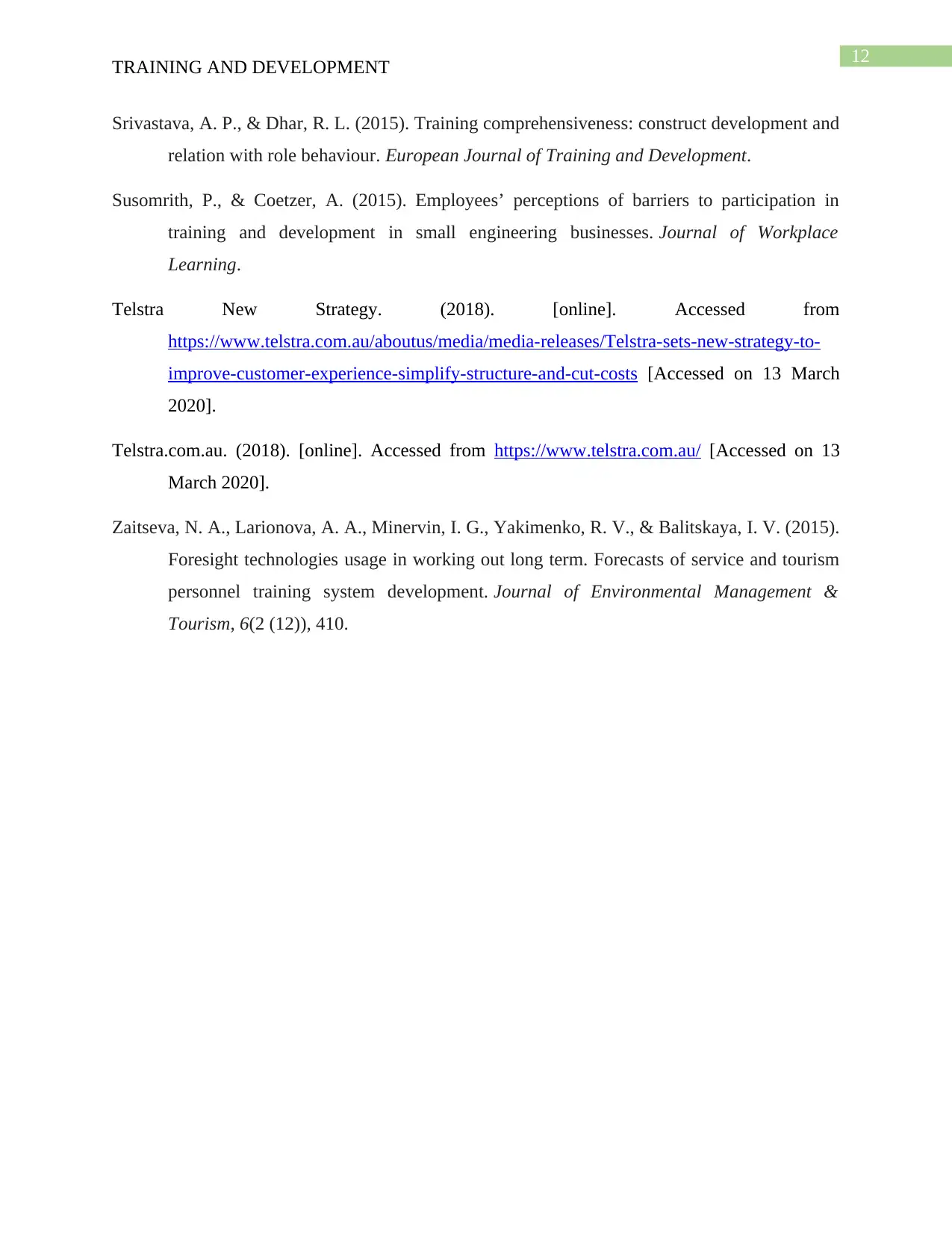
12
TRAINING AND DEVELOPMENT
Srivastava, A. P., & Dhar, R. L. (2015). Training comprehensiveness: construct development and
relation with role behaviour. European Journal of Training and Development.
Susomrith, P., & Coetzer, A. (2015). Employees’ perceptions of barriers to participation in
training and development in small engineering businesses. Journal of Workplace
Learning.
Telstra New Strategy. (2018). [online]. Accessed from
https://www.telstra.com.au/aboutus/media/media-releases/Telstra-sets-new-strategy-to-
improve-customer-experience-simplify-structure-and-cut-costs [Accessed on 13 March
2020].
Telstra.com.au. (2018). [online]. Accessed from https://www.telstra.com.au/ [Accessed on 13
March 2020].
Zaitseva, N. A., Larionova, A. A., Minervin, I. G., Yakimenko, R. V., & Balitskaya, I. V. (2015).
Foresight technologies usage in working out long term. Forecasts of service and tourism
personnel training system development. Journal of Environmental Management &
Tourism, 6(2 (12)), 410.
TRAINING AND DEVELOPMENT
Srivastava, A. P., & Dhar, R. L. (2015). Training comprehensiveness: construct development and
relation with role behaviour. European Journal of Training and Development.
Susomrith, P., & Coetzer, A. (2015). Employees’ perceptions of barriers to participation in
training and development in small engineering businesses. Journal of Workplace
Learning.
Telstra New Strategy. (2018). [online]. Accessed from
https://www.telstra.com.au/aboutus/media/media-releases/Telstra-sets-new-strategy-to-
improve-customer-experience-simplify-structure-and-cut-costs [Accessed on 13 March
2020].
Telstra.com.au. (2018). [online]. Accessed from https://www.telstra.com.au/ [Accessed on 13
March 2020].
Zaitseva, N. A., Larionova, A. A., Minervin, I. G., Yakimenko, R. V., & Balitskaya, I. V. (2015).
Foresight technologies usage in working out long term. Forecasts of service and tourism
personnel training system development. Journal of Environmental Management &
Tourism, 6(2 (12)), 410.
⊘ This is a preview!⊘
Do you want full access?
Subscribe today to unlock all pages.

Trusted by 1+ million students worldwide
1 out of 12
Related Documents
Your All-in-One AI-Powered Toolkit for Academic Success.
+13062052269
info@desklib.com
Available 24*7 on WhatsApp / Email
![[object Object]](/_next/static/media/star-bottom.7253800d.svg)
Unlock your academic potential
Copyright © 2020–2025 A2Z Services. All Rights Reserved. Developed and managed by ZUCOL.




